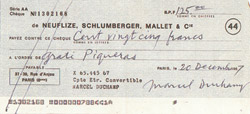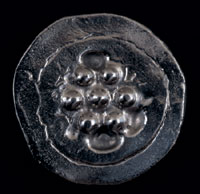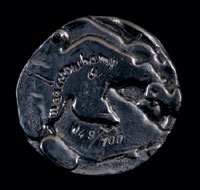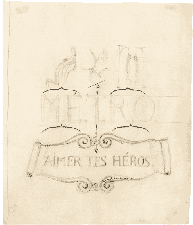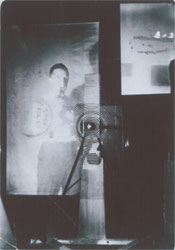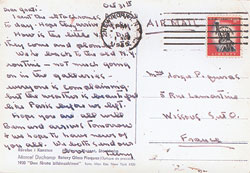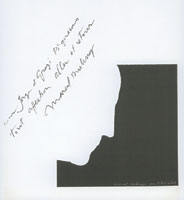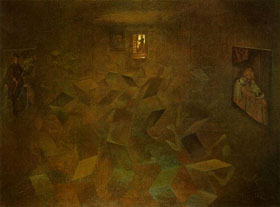|
Although there hasn't been the equivalent for these years of what there is for Duchamp's travels to the American West in 1936, 1949 and 1963,(1) or for the long time spent in Argentina by Polish writer Witold Gombrowicz,(2) several analyses of Duchamp's finished and continued work during his Spanish days as well as several documents (correspondence, photographs, etc.) and relative accounts have been published.(3) A bibliography assembling these elements, however, has gone unaddressed. But here, upfront, are two brief unpublished accounts of the 1960s from some lesser known (or even unknown) individuals to Duchampians.
Conversation without quotation marks with Grati Baroni.(4) Grati Baroni and Jorge Piqueras, both born in 1925, had four young children when they met Teeny and Marcel Duchamp in 1960. It was on account of Emilio Rodríguez-Larraín, a Peruvian painter, who was spending the summer in Llançà, near Cadaqués, with his friend Piqueras, a Peruvian painter of Spanish origin. It was in August. Francesca, our last child (born June 10th), was a little less than three months old.(5) For eight years, until Marcel's death, the Piqueras and the Duchamps saw one another in Cadaqués, in Paris, and in Wissous, near Orly, (Wissous being where they lived from 1961 to 1966). They saw each other nearly every day in Cadaqués (except July-August 1968, when Grati was in Rome on a family matter) and frequently when the Duchamps were in France, at their (the Duchamps') house or sometimes at the Lebels'. We kept an eye on the Duchamps' car while they were in the United States and we were the ones who, with or without Jacqueline Matisse, Teeny's daughter, would many times go and pick up the Duchamps in Orly when they arrived from New York.
And so it was that one day in 1962 or 1963--more probably 1963 than 1962 when I think back on it--the Faux-Vagin (Fig. 3) was "made" on the way back from Cadaqués,(6) around mealtime in Wissous, as a "joke," without documentation or any title inscribed on the work.(7) Just a dedication and a signature: "pour Grati / affectueusement / Marcel" [for Grati / affectionately / Marcel]. (Fig. 4) And Teeny was saying, "Tiens, tu as un readymade!" [There, you have a readymade!] You can't imagine the "tricks," the word plays that Marcel was already making with the Volkswagen. For example, "Teeny est partie avec sa Faux-Vagin." [Teeny's left with her False-Vagina.](8) We accompanied him in the small villages around Cadaqués where he would play in important chess tournaments and where he would very often win. This
friendship was a comfortable friendship, nothing self-interested. In
1961, we were already on familiar terms with each other. In the following
years, the friendship grew deeper still.
*** Baroni is an Italian name. I was born in Florence: a Florentine can't be naive, she can decide to be good, but she can never be naive! Grati is a name probably invented by my godfather, a nickname which was always used to address me and which became my real first name. And Grati Baroni de Piqueras (with a de), this was my married name. Since our separation, I've gone back to Grati Baroni, very simple. I lived in Italy, in Peru (1952-1956), and then in France. I had a knowledge of art history but not a degree. I started painting when I was very young, fourteen years old, and painted until the 1950s and 60s. Then after a break I began to paint again. Marcel, though terribly concerned with contemporary art, would speak with me about paintings from the Renaissance. Everything, in this sense, interested him. And he was very aroused by physical beauty. He loved us, I think, for the couple that we were, that we created: a symbiotic couple, "mythical." We were very beautiful. And I remember that he told me that one day when he was forty or forty-one, when he was in New York and very much in love, he was in front of a profound hole in the street that was being repaired; he was drunk and, upon seeing this hole, in one fell swoop he sobered up, for good!(9) Marcel was tremendously helped by Arensberg, Dreier, etc.; did he want to help others in turn? He was very generous with Piqueras, for example, in introducing him to the Staempfli Gallery. George and Emily Staempfli had a house in Cadaqués. I remember one evening in particular where the Dalis, the Duchamps and us, we were at the Staempfli's house. Dali, that very same day if I'm not mistaken, had painted a small picture entitled Le twist, an allusion to a dance that was all the rage those months.(10) On the other hand, I was never informed about Marcel's plan for Piqueras regarding Noma and Bill Copley, a plan set for the first days of June 1964 and which never resulted in anything.
Marcel was very generous with his knowledge and his advice. Each Christmas, he sent a check to the children and he did this till he died. The last check, or what would become the last check, dated December 20, 1967, we have never touched. (Fig. 5) I was in Cadaqués the day when Marcel made what he would entitle Medallic Sculpture. This happened, if my memory serves me correctly, the same year that Man Ray came to Cadaqués to see Marcel. In his Autoportrait, he speaks of this 1961 visit. The problem for Marcel was finding a way to "fill up" the bath [le bain-douche] in his small apartment: more of a "bath stopper" [Bouche-douche], in effect, than a "sink stopper" [Bouche-évier]. (Fig. 6) He first made a plaster model, then a metal one, and this remained a utilitarian object for several years, in fact, until he agreed to permit the International Collectors Society of New York to make it into an art object in 1967. click
to enlarge
That year [1961], Man Ray and Marcel were making a telephone with empty tin cans and a cord, in order to speak to one another--like children--from their rented castles! If I remember this right, it was in Paris in 1962 that we introduced Marcel to Gianfranco Baruchello, the Italian painter, who would later invite him to Italy several times.(11) Plus, Baruchello had known Arturo Schwarz who was already working on Duchamp.(12) In Europe, the artistic activity of Duchamp, during this period in any case, was not so well-known. And we introduced Baruchello to the art critic Alain Jouffroy, who had already been to our house in Wissous for a dinner with Marcel; Jouffroy wrote pieces on Baruchello and Piqueras.(13)
It was also in Paris, in 1962 I think, that we introduced Marcel to Bruno Alfieri, director of the review mETRO and godfather to our daughter Francesca. You know what happens next: the small drawing entitled M.É.T.R.O. (1963). (Fig. 7) It was in Cadaqués in August 1962, through Marcel, that I met his sister Suzanne. I sympathized greatly with her. She told me a lot of stories about him, such as when they were children and adolescents, there was a complicity between them, an incredible communion: she would think of something and he would come up with it, and vice-versa. They were as one. September 30, 1968, two days before his death: "You, I want to see you alone." A message of enormous affection. We went to his apartment, in Neuilly, for dinner. After his death, our closeness gradually blurred. The rupture between Jorge and me took place in 1969 and our separation, in 1973. It wasn't until much later, through our son Lorenzo, that we replanted the seeds of our friendship with Teeny and Jacqueline who very much appreciated the exhibition, L'époque, la mode, la morale, la passion, on which Lorenzo worked as an architect.(14) After the exhibition Paris-New York,(15) to which I lent a work by Suzanne Duchamp that I liked a lot, Étienne-Alain Hubert came to my house and "discovered" the targa (Faux-Vagin), a private, intimate "thing." One never discovers a work of art in my house. It was exhibited for the first time in a museum in Japan, during August and September 1981, and reproduced for the first time, although in black and white, in the catalogue for this exhibition. When I had to sell this readymade, and it distressed me to sell it to someone who didn't love Marcel as we did, I contacted Bill Copley first, but he wasn't interested. I also tried Jasper Johns, but he wasn't interested either. And so it disappeared into the art market. Shame... I would give anything today to have it again.
I knew a lot of artists (Fernand Léger, Constantin Brancusi, Henri Cartier-Bresson, etc.) but stayed voluntarily on the sidelines. I have a total respect for the other: who he is (as a person), what he does (in his work). I have nothing left--nothing kept, nothing hoarded--and I want nothing. I didn't want to take what my Italian friends--Giacometti, Magnelli, Fontana--suggested I take... What then remains of our time together? Of my time with the Duchamps? Perhaps Rodríguez-Larraín saved some documents like some letters or photos of our vacations.(16) However, I regret not having kept a journal, even minimally, during that period. True friends don't make plans! I have lived intensely in all of my relationships which were exceptional, meaningful and fulfilling. With my family, it's the same thing: I have very few photos.
Appendix Postcard from Teeny (New York, October 31, 1965) to Grati: (Fig. 8) click
to enlarge
• Five Qestions for Emilio Rodríguez-Larraín (19) What is the
broad outline of your C.V.? I was born in Lima in 1928. My first solo exhibition went up in 1950, my first group exhibition in 1951. From the time I met Marcel Duchamp, I had (and would have) solo exhibitions in Milan (1959, 1960, 1961, and 1963), Cologne (1960), Frankfort (1960), Berlin (1960), New York (1962 and 1965, at the Staempfli Gallery; 1967, at the Rose Fried Gallery), Washington (1963), Brussels (1965), etc. I received an award from the William and Noma Copley Foundation in 1965; Marcel Duchamp, Man Ray, Max Ernst, Roberto Matta and Walter Hopps, among others, were the judges. How did you come to meet Marcel Duchamp? Where, when and how did that happen? I knew Marcel Duchamp through Gordon Washburn, director of the Carnegie Institute of New York. He had come to Milan to invite me to an exhibition at the Carnegie Institute.(20) We had become very close with him and his family. He asked me where we were going to spend our vacation, and they came to join us at Llançà, on the Costa Brava. There he realized we were close to Cadaqués, where Marcel Duchamp often went, as did Salvador Dali, Man Ray, and others. We went there and he introduced me to all these great artists. Where did you get in the habit of seeing each other? With
Marcel Duchamp, it was an instant friendship. He came to Llançà,
we would go to Cadaqués,
we would find ourselves in Paris, in Neuilly, in New York. What was your rapport like with him and with Teeny? Quotidian life with Marcel Duchamp and Teeny, which meant art, chess, language, walks, bulls, as much in Paris as in New York or on the Costa Brava. What was Duchamp for you, ultimately? A
great friend, as much him as his wife, and an artist that I respected
and continue to respect very much, finding him the most lucid man I've
ever known, generous and courageous. Adjoining
Documents:
• A dedication of Robert Lebel's book Sur Marcel Duchamp (1959), to M. and Mme Piqueras, most likely from 1960. (Coll. G. Baroni, Paris.) (Fig. 9) • Two photos of Emilio Rodríguez-Larraín at the opening of Not Seen and/or Less Seen of/by Marcel Duchamp/Rrose Sélavy, 1904-1964, New York, Cordier & Ekstrom, January 13, 1965. To his right in one of the photos: George Staempfli; behind his right elbow in the other photo: Marcel Duchamp! (Coll. E. Rodríguez-Larraín, Lima.) (Figs. 10 & 11) • Postcard from Teeny Duchamp to Mme Jorge Piqueras, October 31, 1965. (Coll. G. Baroni, Paris.) • Check from Marcel Duchamp to Grati Piqueras, December 20, 1967. (Coll. G. Baroni, Paris.) • Two photos of a wall at the bar Meliton, Cadaqués. (Coll. André Valois, Montréal, 1994.) Around a plaque which reads "AQUI JUGAVA ALS / ESCACS L'INOBLIDABLE / MARCEL DUCHAMP" ["Here used to play / chess the unforgettable / Marcel Duchamp"], some artifacts recall the presence of the man: two photographs, a letter (regarding a meeting at the café), the reproduction of a picture by Jacques Villon representing Duchamp in about 1951, and a mirror on which the name of the bar has been broken down ("me / mel / elit / lito / liton," etc.) between the words "ciel" [sky] and "champ" [field].(21) (Figs. 12 & 13)
Notes
Figs.
3, 4, 6-8 |
|||||||||||||||||||||||||||||||||||||||||||||||||||




